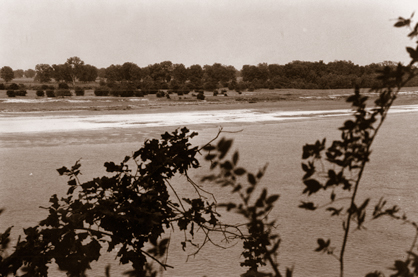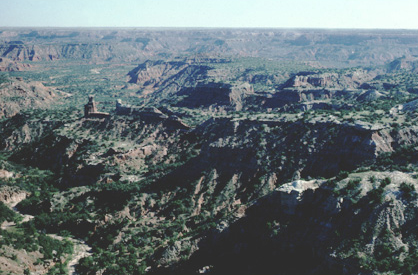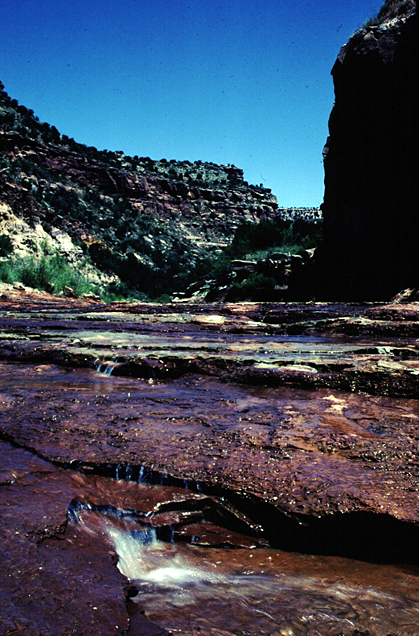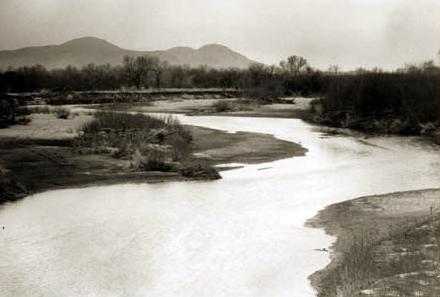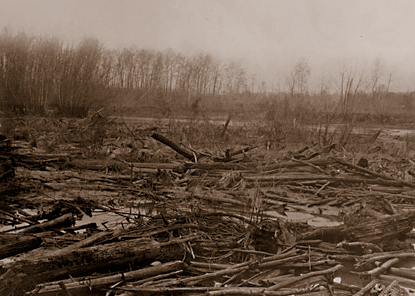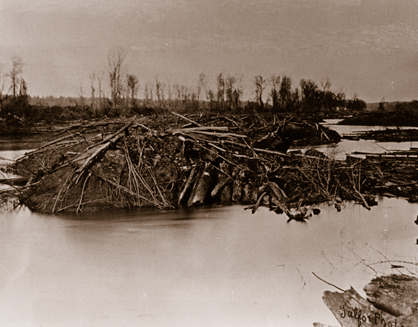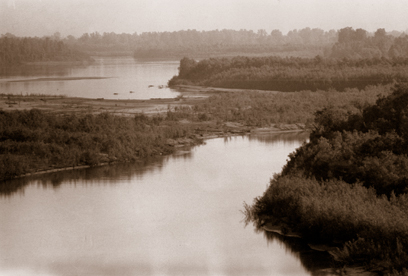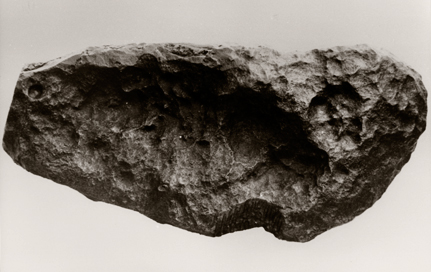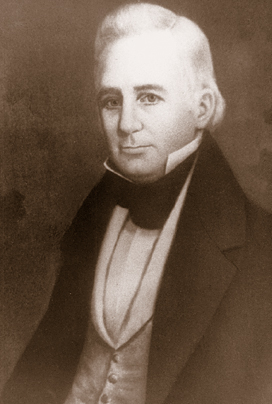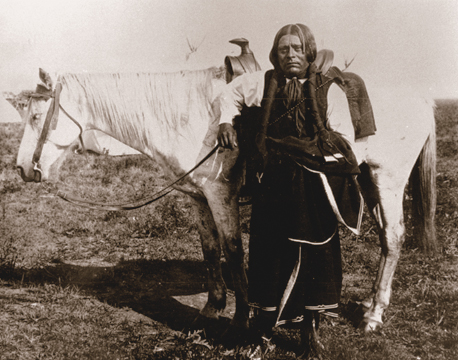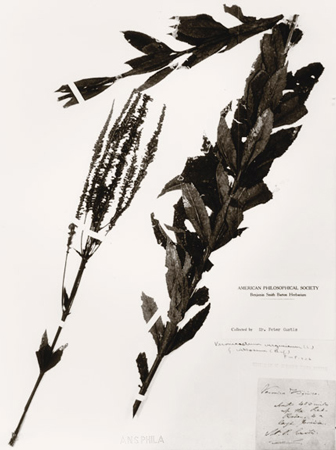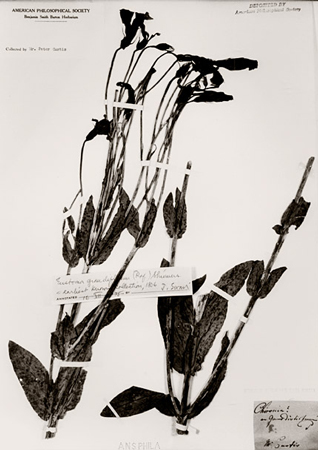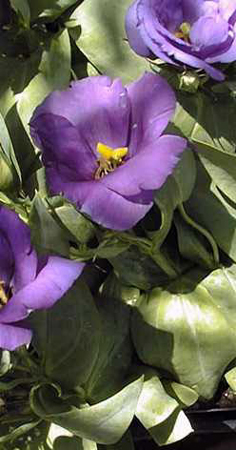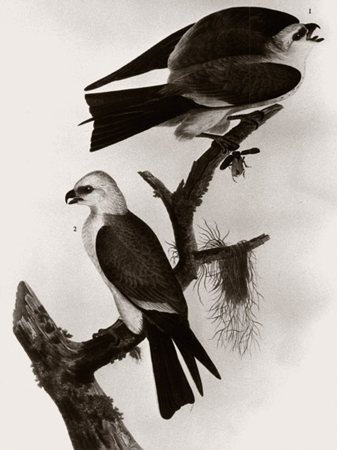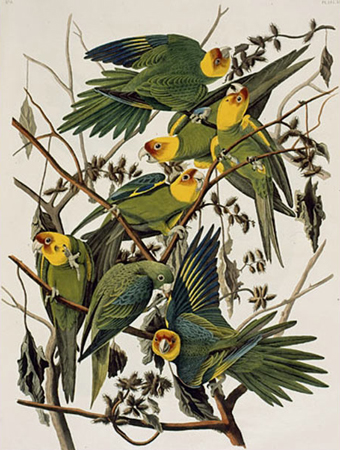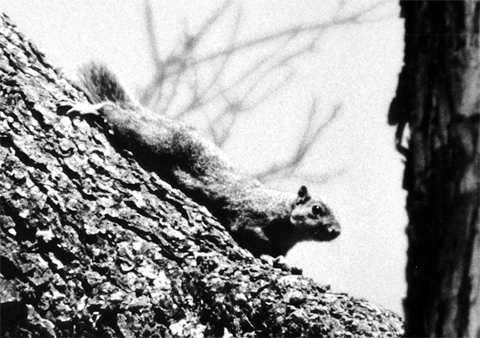An interview, in English, with Daniel Flores telling the story of a parallel exploration, the Freeman-Custis Expedition.
Learn more about the seven areas labeled on the above map:
- Spanish Bluff
- Sante Fe
- Palo Duro Canyon
- Tule Canyon
- North Fork of the Red River
- The Great Raft
- The Middle Red River
Amarillo, Texas, has been included on this map merely as a reference point. It was founded in 1887 as a railroad construction camp, and grew to be a center of ranching, wheat farming, and oil drilling. It is on the low divide that separates the Red River drainage from the Canadian River drainage in the Texas panhandle.
Chihuahua, the present capital of the Mexican State of Chihuahua, was originally settled in the 16th century, and “officially” founded in 1709. At the end of the 18th century it was a commercial center on the 1,600-mile Camino Real (“Royal Road”) that connected Mexico City with Santa Fe.
—Joseph Mussulman
Transcript with additional commentary:
I think the striking thing about this expedition is that there was a second expedition into the Louisiana Territory, another Lewis and Clark Expedition, if you will, but not one that was led by Lewis and Clark. Thomas Jefferson clearly intended Meriwether Lewis and William Clark to lead a singular expedition, one that would traverse the Missouri and Columbia Rivers, but Jefferson never seems to have had in mind the idea that this was the only part of Louisiana that needed to be explored. Almost from the very beginning, in fact, he was almost equally interested in the southern reaches of Louisiana. And I think part of the reason that southern Louisiana appealed the way it did is because the boundary of the Louisiana Purchase on its southwestern side was equally vague in terms of where the Americans and where the Spaniards would draw a line between their respective imperial reaches. It was equally as vague as the boundary in the Northwest between the British and the United States on the other end of the Louisiana Purchase.
See Nau’s annotated map of the Red River
And so Jefferson was intrigued not only by his hope to resolve the boundary question, but as he began to learn more and more about the . . . southwestern part of what is now the United States he became intrigued by what kind of possibilities for commerce—that was always one of his interests in exploration in the West—and also what kind of possibilities for science, geography and natural history study would emerge from an exploration of Louisiana. So as early as 1804, even before Meriwether Lewis and William Clark left to ascend the Missouri River, Jefferson wrote Meriwether Lewis. He said, “the object of your voyage is singular,” and he went on to describe the ascent of the Missouri and descent of the Columbia.
And he said, I will also attempt to send an expedition up the Red River, which was the southernmost tributary of the Missouri coming in from the west, and he said, that expedition then will ascend the Red River, cross over to the headwaters of the Arkansas River, which was the next river, working your way up from the mouth of the Mississippi, coming in on the west side of the Mississippi. The expedition would then cover these two southerly reaches of the Mississippi River system. That would eventually lead an American team into the Southwest.
A Forgotten Journey
Perhaps the second thing about this expedition into the Southwest that’s intriguing is that hardly anyone’s ever heard of it. And there’s a really good reason for that.
This expedition was not, as Jefferson himself put it to Congress in 1807, nearly so successful as that of Lewis and Clark. The reasons why it wasn’t successful have to do with the diplomatic tangle of the times, and with the fact that Jefferson launched this expedition into a part of the West that was a lot more accessible to other European powers than the Lewis and Clark expedition up the Missouri ever was. Because it was aimed at the Red River, and hopefully the Arkansas River as well, a Southwestern expedition would lead Jefferson’s explorers onto the boundaries of Spanish territory—in fact, within a hundred miles of the nearest Spanish presidios and missions, in what is now Texas.
And the fact that this expedition, as Jefferson planned it, was going to graze, or even penetrate, Spanish territory, made it possible for the Spaniards to react to it in a way that they couldn’t react to Lewis and Clark. They hoped to stop Lewis and Clark on a number of occasions. They were never able successfully to do so, but Spain, in the case of this Southwestern expedition, was able to send out an expedition to stop it.
Determining Boundaries
The question of the boundary of the Louisiana Purchase of course was a critical issue to any exploration, either into the northern reaches or the southern reaches of the Purchase. And I think the boundary question on the south was especially vexing for Jefferson’s administration, in part because Louisiana was purchased from a French government that had not actually taken possession of Louisiana from Spain, and a French government that hadn’t actually owned Louisiana in something like thirty-five years. Napoleon’s . . . what he called a retrocession of Louisiana to France in 1800 only lasted for three years. And it was such a brief time that France never sent any of its officials to Louisiana in order to take over the management and control of that province.
And so in order to determine the boundary between Spanish and American possessions, both American investigators and Spanish investigators had to look back thirty-five or forty years to try to determine what the boundary had been between France and Spain in the Louisiana Purchase Texas area back when both those powers had been on the continent.
In fact, there was even a major work published out of all this, by a Spanish priest called Father Pichardo, that attempted to refute the American claim as to where the boundary was. The reason Picardo felt like he had to refute the American claim was because Jefferson, doing research in his own library, concluded that the actual boundary of the Louisiana Purchase on its southwestern side was the Rio Grande River, which meant that all of Texas and half of New Mexico would actually end up belonging to the United States.
Spain of course, was not by any means willing to honor that sort of claim. I think you’d have to say that it was kind of a spurious claim at best. It was based on a very short-lived French colony in the 1680s. So Spain basically asserted that the boundary of the Louisiana Purchase extended from the Sabine River northward to the Missouri River. Spain essentially outdid Jefferson in asserting a grandiose claim to the West.
And so that meant that, in essence, the entire country between the Missouri River and the Rio Grande was up for grabs. It was up for some sort of resolution. And I think one of the reasons the Red River of the South became the place where Jefferson decided to send an expedition was because it would serve as a suitable compromise boundary between the Rio Grande and the Missouri.
Jefferson’s Southwest Plan
One of the things about the Southwestern Expedition up the Red River of the South that makes it a really intriguing one is that, like the Lewis and Clark Expedition—and unlike the expeditions of Zebulon Montgomery Pike, for example, which occurred during that same period, the first decade of the 19th century—this expedition was actually planned and set in motion by Thomas Jefferson himself. So it was one of two expeditions, the Lewis and Clark Expedition being the other, that actually was plotted and planned from Monticello, and from Washington, D.C. during the Jefferson administration.
It bears the stamp of Jefferson all over it. In fact, there is even a letter which was discovered in the early 1980s—I think I was the first person to come across a copy of this letter—that is a letter of exploring instructions that Jefferson drew up in April of 1804 to whomever would end up becoming the leader of this Southwestern Expedition. And it’s a letter of exploring instructions that is remarkably similar to the one that he gave to Meriwether Lewis. It’s different, of course, in terms of which rivers are to be explored, but in terms of how Southwestern explorers are to treat with the Indians. The passages dealing with that part of the letter are very, very similar to the passages in the letter from Jefferson to Meriwether Lewis. With a bit more obligation on the part of southwestern explorers to win the Indian tribes over to the United States, because after all, these are Indians who are regularly trading with Spanish authorities in Santa Fe and San Antonio.
So Jefferson is very interested in having his explorers present American flags, and tell the chiefs of the tribes like the Caddos and the Wichitas and the Comanches and the Kiowas, for example, that the United States is the new “great father” that they’re going to be dealing with.
The letter also is very explicit and again very similar to the Meriwether Lewis letter in terms of the scientific component of the probe. It lists, for example, how the naturalist of the expedition, whoever that would turn out to be—Jefferson hadn’t appointed either a leader or a naturalist in 1804—the letter described how a naturalist was going to write a description, a scientific description, and collect specimens of every new species that was unknown in the Eastern states, take the temperature of the air and the water four times a day, keep very careful records of the Indian tribes encountered, the mythologies and languages, and so forth, of those tribes. Basically, the naturalist would do what we would now call ethnology, or ethnography, basic field anthropology among the Indian tribes of the Southwest.
The letter also included a very interesting passage, and it’s worth mentioning it, because it didn’t originate with the letter describing Southwestern exploration. It actually originated with the Meriwether Lewis letter. But it’s a passage that became critically important to the Southwestern Expedition. And the passage, roughly paraphrased, goes like this: Jefferson said, If you are confronted by a force, either authorized or not authorized by a nation, irrevocably opposed to your continuing up the river, we want you—”we” meaning the administration—want you to turn around and return with whatever information you’ve gathered up until this point, rather than try to push your way through.
In other words, Jefferson was telling his explorers that their lives were too valuable to be risked. And in fact the letter includes a sentence something like that. Their lives are “too valuable to be risked in a violent and dangerous encounter” with either an Indian group or a power authorized by a foreign nation.
That particular passage was not one that Meriwether Lewis and the Lewis and Clark Expedition ever really had to go back and re-read, to make sure they were doing everything right. But it was one that eventually the Southwestern Expedition had to call on, because that was precisely what happened to them.
Equipping the Grand Excursion
This Southwestern exploration—which Jefferson, by the way, and the principals involved, took to calling “The Grand Excursion”—I think has a really interesting kind of background history to it in terms of how it’s equipped, and how it’s manned. Because clearly there was no second Meriwether Lewis in Jefferson’s household, to lead a second expedition into the West. And I think that’s borne out by the fact that it took Jefferson almost two years to find a suitable leader for that Southwestern Expedition.
Another thing about the Expedition and its manning and equipage that is interesting is that it’s often been said that some of the members of the scientific community at the time of the Lewis and Clark Expedition, were concerned that Jefferson was entrusting the scientific component of the Lewis and Clark Expedition to Meriwether Lewis, who basically was an amateur scientist, who had a few weeks of crash courses in Philadelphia to prepare him for all the array of scientific discoveries that he was expected to do. And yet Lewis did not avail himself of a professional naturalist on that expedition.
A third aspect of the Lewis and Clark Expedition that’s probably germane to the Southwestern probe is the one that has bedeviled students of the expedition for two hundred years now, and that is that Lewis and Clark almost don’t provide us with any visual images at all. They scribbled a few drawings in their journals over the two-and-a-half-year course of the Expedition, but by and large, in order to envision what the West was like between eighteen-four and six, you have to really kind of put your imagination to work trying to extrapolate Meriwether Lewis’s words into visual images.
The Southwestern Expedition, on the other hand, is not only going to have a professional naturalist attached to it, which answers that critique of Meriwether Lewis’s skills and qualifications, but it also included a device known as a camera obscura among many of its other technological devices for up-to-date exploration, that was going to enable the Southwestern party to actually take profiles of the landscape. That camera obscura box is the forerunner of the modern camera. The Southwestern party took it along, but no images ever taken with it have survived. So we don’t know whether or not they ever actually used that camera obscura, but at least they did have the capability of doing visual images.
The descent of the river from July the 29th to September first was not really exploring, in fact, and the party, when they returned to the Alabama Cashatta village above the Great Raft actually borrowed horses from the Indians and detoured around the Great Swamp this time, and arrived back in Nacogdoches on September the first. I might point out that this is the same month that Lewis and Clark arrived in St. Louis from their 28-month, 8,000-mile Expedition to the Pacific.
Searching for Leadership
The Expedition has a history that lasts from 1804 to 1806 before it’s ever launched into the wilds of Western North America. And that history involves a two-year search for leaders, a search that in fact involved many of the most famous scientific names in early American history. That’s one of the perplexing aspects of the Expedition in terms of its near-invisibility, I think. That it did involve people like Alexander Wilson, the man now known as the Father of American Ornithology; Constantine Rafinesque, who was one of the great naturalists, sort of an erratic fellow, but one of the great naturalists of the 19th century; William Bartram, who was world-famous at the time Jefferson inquired as to whether he was interested in going on the Southwestern Expedition; he was sixty-five years old at the time, though, and the author of Travels in North America was not interested in taking the Expedition.
But that two years of preparation before the Expedition was sent out in 1806 involved not just a search for people to man the expedition, but also a rather complex equipage that essentially put together telescopes, chronometer, sextant, trade goods for the Indians in the West; two specially-constructed flatboats for ascending the shallow rivers of the southwest. Now they were completely experimental boats—had never been constructed before. We don’t really know quite how well they performed on the Expedition, because the Expedition doesn’t get far enough into the Southwest to determine how well they would have done in shallow rivers. But it’s an extremely well equipped expedition, and one of the reasons it was is because Jefferson got Congress to appropriate twice the money for this Grand Excursion into the Southwest than Congress had appropriated for Lewis and Clark. Congress had come up with the munificent sum of two thousand five hundred dollars for Lewis and Clark. Lewis, of course, had free chits on the War Department from Jefferson, and he ended up spending something like thirty-eight thousand dollars on the Lewis and Clark Expedition.
Congress appropriated five thousand dollars for the Southwestern Expedition, and it ended up costing, after all was said and done, about eight thousand seven hundred dollars. It probably would have cost more, except for the fact that it doesn’t end up reaching its objectives.
Trial Run: Dunbar and Hunter
Finding a leader for this Southwestern Expedition proved to be a really difficult task in early America. Jefferson, fairly early on in the process decided that he would enlist the assistance of a Scottish expatriate scientist who was living in Natchez, Mississippi, near the mouth of the Red River of the South. His name was Sir William Dunbar.
He was quite a famous character in early American history. Lived in a plantation that he called “The Forest,” outside Natchez, where he was reputed to have had probably the best astronomical observatory in Jeffersonian America. He regularly published in the Edinborough Review, was one of those, sort of transatlantic figures.
And since he was on the scene, so to speak, in the Southwest, Jefferson decided to ask Dunbar if he would play a role in the Expedition. I think Jefferson had in mind possibly having Dunbar lead the expedition. Dunbar was intrigued by that—he sort of flirted with the idea, but what he agreed to do was to act as the on-the-scene director of the Expedition. And so this Southwestern probe, the Grand Excursion into the Southwest, will end up being fitted out, in its last stages, at Dunbar’s home outside Natchez, Mississippi.
William Dunbar had a friend in Philadelphia whose name was Doctor George Hunter, who was a chemist. Not a well-known naturalist, but a naturalist who had some European training. And Dunbar and Hunter decided, in the winter of eighteen-four and eighteen-five, to perform what amounted to a trial expedition for the Grand Excursion into the Southwest. With sixteen men they led a short, four-month probe up the Washita River, a tributary of the Red River, into what is now the Ozark Mountains of Arkansas. To the Hot Springs country, in fact. Both men were in their fifties. They were the first explorers, in fact, to report back from the Louisiana Territory. And no less than John James Audubon would later write that Dr. George Hunter was “that renowned man of Jefferson.” George Hunter was known as a Jeffersonian explorer for the rest of his life, and he lived into the 1830s.
This little expedition, this trial run into the Ozark Mountains of Arkansas, in the winter of eighteen-four and eighteen-five, convinced both Dunbar and Hunter, though, that they didn’t want to go on the Grand Excursion up the Red River. And so Jefferson’s hopes to get those two men to lead the big exploration into the Southwest, dissolved after the expedition into the Arkansas country. Dunbar, however, continued to act as the on-the-scenes director, and he and Jefferson kept up a wonderful correspondence in eighteen-five and eighteen-six as Jefferson and Dunbar tried to find leaders for this southwestern probe. [For more, see Hunter and Dunbar Expedition.]
Freeman and Sparks Selected
Eventually six different leaders for the Red River-Arkansas Expedition were considered before, finally, in November of 1805, Jefferson settled on a young man who seems to have been about thirty-five years of age—we don’t know exactly how old he was—whose name was Thomas Freeman.
Thomas Freeman, unlike Meriwether Lewis, was not an officer in the American Army, he was a civilian. He was a civil engineer and a surveyor who in fact was an Irish immigrant to the United States. He had a whole range of political contacts across the spectrum in early America. He was a friend of Alexander Hamilton, for example, of the Federalist Party. Played a role in surveying Washington, D.C.
And he seems to have been brought to Jefferson’s attention by William Patterson, that mathematician at the University of Pennsylvania who had tutored Meriwether Lewis. Patterson suggested Freeman in the summer of 1805, and in November of 1805 Freeman had a private dinner at the White House with Thomas Jefferson, where Jefferson, after two years of searching, finally turned over that letter of exploring expedition—or, exploring instructions—and inscribed “To Thomas Freeman, Esquire” across the top of it.
So Jefferson finally had a leader for his expedition. It was a civilian leader, however, and that’s one of the aspects of this party that makes it different from Lewis and Clark. It’s led by civilians rather than by the American military.
Jefferson was concerned, however, that a military detachment was going to have to be added to the Expedition, and so, with the advice of Meriwether Lewis, who had done a careful appraisal of all the officers in the American Army (see Lewis’s Report on Army Officers, Jefferson selected a Virginian by the name of Richard Sparks, captain Richard Sparks, to lead the military contingent that would be attached to this southwestern probe.
Peter Custis Selected as Naturalist
And that, of course, left the post of naturalist to be filled. And as I mentioned, that search included discussion with William Bartram and Rafinesque. Alexander Wilson was extremely desirous of having the post of naturalist on the expedition, and through William Bartram he tendered a letter of application to Jefferson in February 1806; sat around on pins and needles during the spring of 1806 waiting for a reply from Jefferson, which never came.
And in fact, Wilson’s biographer accused Jefferson of disgracing himself by never bothering to respond to Alexander Wilson’s letter of application. I’ve looked for Wilson’s letter of application in the Jefferson letters, and never found it. I have found Bartram’s letter of introduction, but Wilson’s letter is not there, and I really wonder if Jefferson ever got it. In any case, by the time Wilson’s letter of application arrived Jefferson had already selected a naturalist for the party
His name was Peter Custis. He was a last-year medical student at the University of Pennsylvania, working under Benjamin Smith Barton, who was the most famous botanist in America at the time, and who was another one of those savants who had helped Meriwether Lewis prepare for the western expedition up the Missouri.
Benjamin Smith Barton was only thirty-seven years of age. He had considered possibly going on one of these expeditions, but decided he couldn’t do it, and so he finally suggested what was one of his top students in the program at Pennsylvania, young Peter Custis, who was from Jefferson’s home county—Albemarle County in Virginia—that was Meriwether Lewis’s home county as well. Custis also was from a very prominent family in Virginia that was related to the Lees and the Randolphs and also even to President Washington. George Washington’s wife, Martha Custis, had been married to a Custis before she married George Washington.
Jefferson didn’t seem to know him personally and wrote that “I hope we’ve acquired a good naturalist.” What they acquired in Peter Custis seems to have been a young fellow who had superior scientific skills—he’s the first academically trained American naturalist to explore in the West. But he didn’t seem to have had any field experience up to this time. And as a result of that lack of field experience, and possibly as a result of some of the sources he took with him to identify plants in the field, he did experience some problems. But he was definitely the best-trained American to accompany an exploring expedition during this entire age. So he’s kind of a foundation figure in American science in the West.
Spanish Misgivings
And then the other thing, of course, is that it’s right in the middle of a near-war with Spain, the Burr conspiracy. Jefferson sort of was content not to call attention to it. The National Intelligencer, which was the administration newspaper, never even included a single line about it. Even though it did a front-page story about the whole affair of the confrontation of the armies in the Southwest, and the Burr conspiracy, and all, never mentioned the exploring expedition one time.
The Grand Excursion into the Southwest, then, was prepared to launch in the spring of eighteen-six. During that spring of 1806 there were some last-minute exchanges between Jefferson and William Dunbar about the objectives of the Expedition. Those exchanges had to do with a very serious problem that had emerged in eighteen-five and eighteen-six, and that was Spanish opposition to the probe.
The Spaniards, for example, refused to issue a passport, which Jefferson asked for, for this expedition. Spanish officials, in fact, were frankly horrified that Americans were going to be exploring on the edge of their settlements, and two-hundred-year-old colonies in the Southwest.
They were also encouraged to be horrified by the actions of a slippery secret agent, General James Wilkinson, who simultaneously was the ranking general in the American Army and also “Secret Agent Number Thirteen” in the employ of Spain.
Wilkinson, in this capacity, spent eighteen-five and eighteen-six sending letters to Thomas Jefferson, encouraging him in his designs on exploring the Southwest, describing for Jefferson what a wonderful country of wonderful productions it was. Saying that the Red River headed in volcanic country, and in mountains of salt, or partial salt. He forwarded to the administration descriptions of unicorns, of giant masses of metal on the southern plains that everyone thought were big masses of silver or possibly platinum. They turned out to be meteorites. In fact; one of them was retrieved from the plains in 1810 by American traders, and it turned out to be a gigantic meteorite, almost two tons in weight.
But these were things that no one had any way of explaining at the time, and Jefferson, always intensely curious about natural curiosities in the West, was really spurred on in his interest in the Southwest by some of these descriptions that James Wilkinson and others—there were quite a number of other people who sent him descriptions of the area in eighteen-five and eighteen-six—were sending in.
Wilkinson, at the same time, encouraged the Spaniards to try to capture and stop these American expeditions in the West. He actually told the Spaniards that they ought to try to send a body of troops to capture Meriwether Lewis and William Clark, and he told the Spaniards in no uncertain terms that if Jefferson sent an exploring expedition into the Southwest there was no way the Spaniards should allow that expedition to penetrate to Santa Fe because, Wilkinson said, if they do, you realize, the revolutionary spirit of the age is going to overtake you.
Spanish Reactions
No one really knows for sure how much the Spaniards were manipulated. I don’t think they had to be manipulated very much. They were determined for their own reasons not to allow the Americans to explore into the Southwest. For one thing, they were afraid of letting the Americans come in contact with the Indian tribes of the southern plains. The Comanches, which were extremely numerous, and had fond memories of the days when the Spaniards and the French had competed for their favors, now looked on the Americans as a new competitor with the Spaniards, and were anxious for the Americans to reach into the southern plains.
The Spaniards had no intention, then, of letting the Americans treat with Comanches and groups like that, and so for their own reasons, the Spaniards were determined to make every effort to block these American expeditions. They sent three different expeditions out to try to capture Meriwether Lewis, but the Missouri River was so far away that these Spanish expeditions were never really able to get close to capturing Lewis.
On the other hand, the Red River of the South was easily accessible to those Spanish troops, and so Spain, in the spring of eighteen-six, began to put together a plan for stopping this Southwestern Expedition. It decided—the Spanish government in Madrid, and in Cuba—decided to, first of all, alert the authorities in New Mexico and in Texas of the impending American expedition. A whole series of Spanish officials, the commandant-general of the interior provinces—whose name was Nemicio Salcedo—personally directed the opposition. He instructed the governor of Texas, whose name was Antonio Cordero y Bustamante, to make sure that the Americans did not get to the Wichita and Comanche country. He said, do whatever is necessary, including a declaration of war on the United States if you have to, but do not allow these Americans to make contact with the Indians of the Southern Plains.
And so, Spanish officials basically threw themselves into a frenzy of activity. They put together two different expeditions to block Jefferson’s exploration. One was launched out of Nacogdoches, a city that was only about a hundred miles or so from Natchitoches, in Louisiana. The expedition from Nacogdoches was led by a man named Francisco Viana, Captain Francisco Viana. It consisted of about two hundred and twelve Spanish dragoons—including an ancestor of mine, who was a lieutenant in that army; his name was Jose Flores, of Nacogdoches. He was one of the officers, in fact, who ended up meeting with Jefferson’s explorers in the summer of 1806.
The other force, that was going to be the insurance force, was launched from Santa Fe under the leadership of Lieutenant Fecundo Melgares. It was a six-hundred-man force, and it was to be the insurance policy, as I said. In case the American expedition somehow managed to slip by Viana—or Viana—Melgares was going to try to confront the Americans farther up the Red River.
As Peter Custis described it in eighteen-six, “This expedition seems to have thrown their whole country into a ferment.” And he was right. The Spanish were determined not to allow this expedition to proceed.
Among the array of scientific discoveries that the Jefferson expedition into the southwest hoped to make, were not only masses of metal (that turned out to be meteorites), mountains of partial salt—and that, in a way, reflected reality because the Red River did, in truth, head in an area that is laced with gypsum; it’s an extremely salt-laden region and so that was not entirely a chimera. But one of the other things that really intrigues Jefferson about the southwest were reports that wild horses roamed the southwest in large herds. In fact, some of his informants told him that there were herds of thousands of wild horses in the southwest. And this really intrigues Jefferson because he said, If true, this is the first time in the modern age that the horse can be studied in its wild state. So he was very interested in having his explorers have a look at these herds of wild horses. Unfortunately, they never do make it far enough west to see those large herds. But this was another reality; the southwest was full of—some estimates are—as many as two million wild horses in 1800.
Destination Santa Fe
The Grand Excursion into the Southwest launched to some fanfare from Natchez, Mississippi, in April of 1806. That required taking these two specially constructed flatboats, these experimental craft, down the Mississippi River about fifty miles, and then into the mouth of the Red River, and turning, then, up the Red River to an exploration the Jefferson administration assumed would be probably thirteen hundred miles, all the way to the mountains near Santa Fe.
At the last minute, just before the expedition left, Jefferson and Dunbar decided to limit the expedition to an exploration of the Red River alone. Part of this had to do with Dunbar’s experiences with portages in that Washita River expedition of a year and a half earlier, and so he basically talked Jefferson into limiting the expedition to one river. Dunbar really wanted to explore the Arkansas River because he was afraid that Spaniards would stop the party on the Red. But Jefferson insisted on the Red River, and so this is the river that the party turned into, then, on May the first of 1806, with the idea of penetrating it some thirteen hundred miles to its headwaters.
Jefferson was interested in the idea of opening up Santa Fe to American commercial development, and he also had the sense that major rivers come out of mountain ranges. He had been given information from General Wilkinson in 1805, in fact, that seems to have come from early American traders that had penetrated into the southwest, that the Red River did, in fact, drain a mountain range. Wilkinson had told Jefferson, by letter, that far upriver the Red River forked. The north fork, Wilkinson said, flows through a range of mountains, and it’s the same mountain range that the Arkansas River heads in. Jefferson assumed, of course, that this was the Rocky Mountains.
In fact, what Wilkinson was describing, from these early trader accounts, was that the north fork of the Red River, which actually flows through the Wichita Mountains of present-day western Oklahoma. The Arkansas River does not head in the Wichita Mountains, it heads in the Rocky Mountains about three hundred and fifty miles farther to the northwest. Wilkinson also said that the main fork of the Red River headed on the east side of a height, the top of which presented an open plain. And he said, that height requires the Indians three to four days to cross. It is almost entirely destitute of water, and when you get to the other side of that immense open plain, that elevated plain, there are waters flowing southward that are presumed to be waters of the Rio Bravo, or the Rio Grande. And he said, to the northwest a line of mountains running north and south can be seen.
Now what Wilkinson’s informants were telling him about was the actual true source of the Red River, which in fact does not drain from the southern Rockies at all, but has its sources in the Llano Estacado, an immense plateau out on the plains of Texas and New Mexico. The headwaters of the Red River is considered to lie today in Palo Duro Canyon, a bright, multi-hued, beautiful desert canyon, that’s kind of a small-scale twin of the Grand Canyon, in what is now the Texas Panhandle.
Jefferson, however, seems to have persisted in his belief, despite this, what he must have thought was confusing evidence, that the Red River came out of the southern Rockies near Santa Fe, and so he sent his expedition, then, in May of 1806, up the Red, with the expectation that his explorers were going to reach the Santa Fe area. That was not, however, to be.
The expedition explored for about three weeks below Natchitoches, in present-day State of Louisiana, which was the last American settlement on the Red River. This is where John Sibly, Dr. John Sibley, the American Indian Agent, was located, and he outfitted the Expedition in June of 1806 with additional trade goods, so that the party could trade for horses from the Wichita Indians when they got far upriver.
Another military contingent was added to the Expedition at this point, and that brought the total size of the Grand Excursion to the Southwest up to fifty individuals, which made it an even larger expedition than the Lewis and Clark Expedition. In fact, it’s the largest American exploring party of the age. It included several French guides, who were going to act as guides to the Wichita villages, and it would ultimately include two or three Caddo Indian guides as well.
So on June the second of 1806 the party left Natchitoches fully outfitted, ready to explore to the headwaters of the Red River. It immediately confronted an enormous and what seemed to be an almost insurmountable problem in the form of a log jam that was called the Great Raft. This Great Raft was perhaps as much as a thousand years old, and it stretched for a hundred miles up the river. In order to get around it, the Expedition, which now consisted of seven boats, had to detour eastward around the Red River, through a creation of the Red River which at the time was known as the Great Swamp. It is considered by ecologists today to have been a swamp land that would have been easily the equal of today’s Okefenokee Swamp in Georgia. It took the Expedition almost two and a half weeks of what Freeman called “incessant toil, fatigue and uncertainty,” to work their way through the Great Swamp and gain the Red River once again above the head of the Great Raft.
Peter Custis, meanwhile, was having a field day cataloging botanical specimens and observing neotropical wildlife. It was a paradise for him, but for the rest of the party this was evidently a real nightmare, trying to get around this Raft. They finally managed to do it in early July of 1806. At that point they stopped at an Indian village of Alabama-Coushattas on the river, where the Caddo Indians, who lived about thirty miles to the west, trooped over and spent four or five days with the explorers, and Freeman went through the classic Jeffersonian presentation to the Caddos and the Alabama-Coushattas about how these Indians, who had formerly been Spanish Indians, now had a new Great Father in Washington, and so forth.
The Caddos told the American explorers that there was already a Spanish army paralleling their movements in the hills about twenty miles to the west of them, and that this army was led by, as the Caddo chief described it, a “very bad man who cut down the American flag that was flying in the Caddo village,” and was preparing to violently stop the American expedition. And so the Freeman and Custis party at this point must have been wondering whether or not they were going to live through whatever the next month of exploring would bring.
Stopped by a Superior Force
But in any case, as Jefferson had instructed them, they proceeded upriver with Caddo guides, and for about an additional three weeks, until, in fact, the date of July the 29th, 1806, the Freeman and Custis Expedition explored up the Red River through what is now northwestern Louisiana, southwestern Arkansas, the northeastern corner of Texas, and they had almost reached the eastern border of what is now Oklahoma, when they rounded a bend in the river and were confronted by the sight of a Spanish army four times their size, arrayed in a position across the river.
Freeman, at this point, consulted his orders, consulted with Captain Richard Sparks, who arrayed the Expedition into a defensive posture. And for two days these two opposing forces, the Americans with their eyes on the American West and the future of the West, and the Spaniards, who represented sort of a crumbling empire in the American west, that was actually into its last decades . . . its last two decades . . . of enjoying any kind of sovereignty in that part of the world—eyed one another on the Red River while Captain Viana of the Spanish force, and Freeman and Captain Sparks of the American force, had two days worth of parleys. Viana was polite, but he was firm.
He said, my instructions are, you cannot proceed beyond this point. He said, this is as far as the French ever established settlements and posts the Americans had passed an old French post about two days before. And the Spaniards had set up their blockade of the river just about fifty miles upstream of that old French post, and Viana said, this is as far as the French ever proceeded on the Red River, the country above this is ours, and you are going to have to retrograde to American territory.
Freeman no doubt looked at Jefferson’s letter of exploring instructions, and read that paragraph where Jefferson told him, If confronted by a superior force, we want you to turn around, and bring back whatever information you have. And so after two days of considering his situation, Freeman decided to turn around.
And so the Expedition had met “the other” in the Southwest, and ended up turning around and proceeding back downriver. That was the fate of Jefferson’s Southwestern Expedition. It confronted Spanish-Americans who were determined not to let it explore into their territory, and it was forced to retrograde.
The outcome of the Expedition led to what almost was a war between the United States and Spain. Two opposing armies in fact confronted one another in the territory between Texas and Louisiana in the summer of 1806. They ended up finally signing the Neutral Ground Agreement of 1806, which established a neutral ground between Spanish and American possessions on the southern border of Louisiana Territory. And that situation prevailed until 1819, when the Adams-Onis Treaty finally established a boundary between the two powers.
The Adams-Onis Treaty, by the way, included the Red River as the boundary between Spanish Texas and American Louisiana.
Custis was, you’ll recall, in the medical program at the University of Pennsylvania. He went back to the University of Pennsylvania, got his M.D. degree in 1807, so he was the physician. He was a trained . . . and after 1807 he was Doctor Custis.
A Lost Expedition
If ever there was a lost expedition in American history, this is it, and it’s one of the . . . I think one of the remarkable things about the Freeman and Custis Expedition that it’s almost totally forgotten. I sort of think that, with the Bicentennial of the Lewis and Clark Expedition, it’s going to enjoy a little bit of resurgence, because it kind of bounds along behind Lewis and Clark like a tail attached to a kite, in a way. People who are intrigued by Lewis and Clark can’t help but be intrigued by the fact that there is another Lewis and Clark type expedition whose fate offers a kind of alternative view of what possibly could have happened to Lewis and Clark had things unfolded slightly differently.
So, it reflects on Lewis and Clark in a way that makes that expedition even more dramatic and exiting than it would be otherwise. There’s another one sent out two years later: it’s blocked by a foreign power.
This expedition became invisible almost immediately. And without going into all the reasons why it did, I think perhaps the most important one was the fact that it didn’t really play into the mythic theme of American expansion across the West. Whereas Lewis and Clark can more or less be seen as an expedition that paves the way for the resulting fur trade, for eventual Oregon Trail immigrations, settlement in the West, and so forth.
This expedition, blocked by the Spanish army in 1806, simply doesn’t play into the idea of American expansion across the Southwest. Now, it may be, in our own time, as the history of the West becomes more multicultural, that Hispanic-Americans in the Southwest will look upon the outcome of this expedition as sort of one of their victories in blocking American imperialist expansion into the West. But, I think in terms of American national history, this is one of those events that can’t be fitted comfortably into the story of a successful kind of migration of the American people across the continent.
Another thing that makes it an invisible expedition to a certain extent is that the scientific results were relatively meagre, and they were undermined really by how the expedition was reported by the Jefferson administration. The map that resulted from the expedition was a remarkable map, but it didn’t really explore very far into territory that the French hadn’t already explored. So it didn’t provide much in the way of new geographical discoveries.
Peter Custis’s work, on the other hand, I think, had things played out a little differently, might have made the expedition very well known and famous, but the way, in fact, Custis’s work did pan out, it made the expedition even more ill-starred. What happened was that Custis wrote descriptions of more than two hundred and sixty-seven plants and animals that he described on this four-and-a-half-month expedition. It’s a remarkable ecological kind of time machine into what the Red River was like in 1806.[2]Examples of Custis’s work include: Culver’s root, Veronicastrum virginium; lisianthus, Eustoma grandiflorum; Mississippi Kite, Ictinia mississipiensis; Carolina Parakeet, Conuropsis … Continue reading
But unfortunately the Jefferson administration, in getting Custis’s work and the account of the Expedition into print, hired a man named Nicholas King to redact—rewrite—the journals of the two explorers. And King evidently was entirely unfamiliar with scientific Latin and Latin nomenclature, and he horribly mangled Peter Custis’s careful natural history work in the resulting publication. It appeared in 1806, An Account of the Red River in Louisiana by Masters Freeman and Custis. It’s a nice account of the expedition, but the natural history part was absolutely awful. And the result was that the American scientific community basically ignored the Expedition. This was just a kind of an embarrassing scientific production by the American government.
A Short Run
The expedition lasted from about the second of April until September the first, 1806. But it was blocked by the Spanish force on July the 29th of that year. In fact, Captain Richard Sparks was promoted a grade, to major, I believe, later that fall, and his promotion was drawn up to date from July the 29th, as a result of his defensive actions when the party confronted the Spaniards.
The descent of the river from July the 29th to September first was not really exploring, in fact, and the party, when they returned to the Alabama-Cashatta village above the Great Raft actually borrowed horses from the Indians and detoured around the Great Swamp this time, and arrived back in Nacogdoches on September the first. I might point out that this is the same month that Lewis and Clark arrived in St. Louis from their 28-month, 8,000-mile Expedition to the Pacific.
Custis went back to the University of Pennsylvania, got his medical degree in 1807, went to New Bern, North Carolina, married the daughter of a fellow physician, set up a medical practice, named a son Linnaeus, and never seems to have practiced natural history again. He lived until 1842—he was the longest-lived of all the people involved in this expedition, and never seems to have gathered any fame from his participation in it.
Thomas Freeman lived until 1821. Jefferson made him, in fact, surveyor general of all the lands south of Tennessee. That was a position he held until his death in 1821. And Jefferson was going to send Freeman up the Arkansas River in 1807. He probably was going to send a naturalist along, too, but we don’t know for certain, because Congress, with the result of the Red River Expedition fresh in their minds, refused to appropriate money for an 1807 examination of the Arkansas River, and so Freeman never got to explore on the Arkansas.
The Expedition today is, as I said, almost an unknown one. In fact, there is today not a single historical marker in Louisiana, Arkansas Texas, or Oklahoma, to indicate that this expedition ever actually took place.
Epilogue
The Red River continued to elude American exploration for another seventy years. The Long Expedition of 1819-1820 was to target the Red River. It set out from Council Bluffs, across the plains to Colorado, explored the Front Range of Colorado, and Stephen Long then followed the Rocky Mountain Front down into New Mexico, looking for a river exiting from the Southern Rockies, which he assumed would be the Red. They found such a river, began following it back east, and after about 350 miles it drained into the Arkansas. It turned out to be the Canadian.
And so the Long Expedition failed to find the headwaters of the Red River too. In 1852 the government sent Randolph Marcy into the southwest to try to find the headwaters of the Red River. He explored up the Red River and got to those canyon lands in the Texas Panhandle, ascended one of the really dramatic canyons there, which is called Tule; Canyon, proclaimed it to be the headwaters, and for about 25 years everyone assumed it was, until army commanders during the Indian wars in the 1870s began discovering more canyons, and more draws and streams farther west.
And so finally, in 1877, Congress sent out another expedition under a guy named Ernest Ruffner, who spent four months, and finally mapped the headwaters of the Red River. It was the last major river in the whole West to be explored. The Missouri and Columbia had long since been explored, the Colorado River had been explored, the Arkansas had been explored. The Red River’s headwaters were finally discovered in the same decade that the headwaters of the Nile were found in Africa. It took till the 1870s.
Notes
| ↑1 | Professor Flores is the author of Jefferson & Southwestern Exploration: The Freeman & Custis Accounts of the Red River Expedition of 1806 (Norman: University of Oklahoma Press, 1984). |
|---|---|
| ↑2 | Examples of Custis’s work include: Culver’s root, Veronicastrum virginium; lisianthus, Eustoma grandiflorum; Mississippi Kite, Ictinia mississipiensis; Carolina Parakeet, Conuropsis carolinensis; and the Louisiana Fox Squirrel, Sciurus niger ludovicianus Custis. |
Experience the Lewis and Clark Trail
The Lewis and Clark Trail Experience—our sister site at lewisandclark.travel—connects the world to people and places on the Lewis and Clark Trail.
Discover More
- The Lewis and Clark Expedition: Day by Day by Gary E. Moulton (University of Nebraska Press, 2018). The story in prose, 14 May 1804–23 September 1806.
- The Lewis and Clark Journals: An American Epic of Discovery (abridged) by Gary E. Moulton (University of Nebraska Press, 2003). Selected journal excerpts, 14 May 1804–23 September 1806.
- The Lewis and Clark Journals. by Gary E. Moulton (University of Nebraska Press, 1983–2001). The complete story in 13 volumes.



